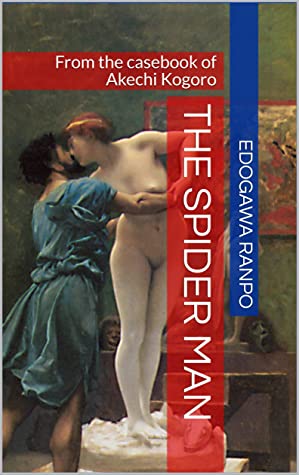 By EDOGAWA RANPO (Zakuro Books; 1929/2020)
By EDOGAWA RANPO (Zakuro Books; 1929/2020)
Another late-in-coming translation of the work of Edogawa Ranpo (a name often rendered in English as “Rampo” but here given its correct spelling), Japan’s grandmaster of all things mysterious and horrific. Initially published in 1929, THE SPIDER MAN was the second novel-length story to feature Akechi Kogoro, a private detective who figured in quite a few Ranpo tales. This is undoubtedly one of Kogoro’s finest outings, being brainy and grotesque in equal measure, and never less than fully absorbing.
No, the novel has nothing to do with the Spiderman we know. Rather, it’s about a villain who, as the opening chapter informs us, “is named the Spider Man since just like the spider he is brutish and otherworldly.” This individual dons various disguises in order to kill unsuspecting women, with his ultimate purpose revealed in the penultimate chapter. Until then the Spider Man blatantly taunts his law enforcement pursuers, Detective Kogoro in particular.
The first victim of this character, known initially as “Bluebeard,” is a young woman who answers a job ad and winds up supplying an arm displayed in a museum exhibit of (allegedly) plaster body parts—and, a few days later, a leg in a high school drawing class. Both are uncovered by “Japan’s Sherlock Holmes” Doctor Kuroyanagi, a highly eccentric criminologist who happens to be crippled, having had a leg amputated, and dominates the novel’s early portions.
As for Spider Man/Bluebeard, he sets his sights on Fuji Yōko, a movie star who closely resembles his initial victim. Following another tip from the Spider Man himself the entire police force descends on the set of Fuji Yōko’s latest film, but of course the killer has a number of surprises in store, as none of his pursuers are aware of, or even suspect, his true identity.
Ranpo, for all his virtues, was known to borrow rather shamelessly from past horror-mystery scribes, Edgar Allan Poe in particular (from whom Ranpo, whose real name was Tarō Hirai, took his better-known pseudonym). Here one can discern the influence of the FANTOMAS novels of Marcel Allain and Pierre Souvestre, as well as the folktale of Bluebeard. That, however, doesn’t lessen the readability of the tale, which is consistently unpredictable, surprising and grotesque, with an outrageous climactic set-piece that recalls the bizarrie of THE BLIND BEAST, Ranpo’s most infamous work of fiction. THE SPIDER MAN, though, is a true original that’s very much a product of its time and place—which, FYI, is meant as a compliment. Likewise the translation by Alexis Brown, who renders Ranpo’s irresistibly demented universe without obfuscation or apology.
